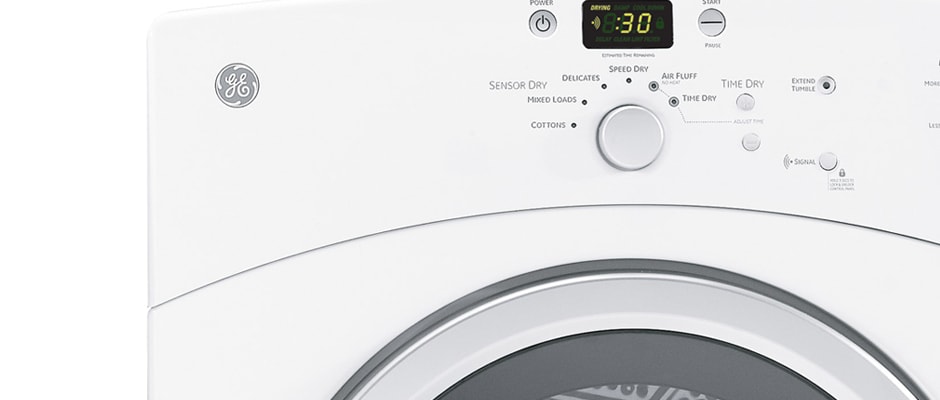Pros
Cons
Introduction
Amidst a jumbled market of less capable dyers—assuming you can track down a sale price—this GE is a competitive choice for shoppers on a budget. If extra features and specialty cycles are what you're looking for though, be sure to keep on hunting.
Design & Usability
{{section_header}}{{section.name}}{{/section_header}}
Limited features make for simple navigation
Few dryers have a simpler set of controls than the {{product.name}}, with its simple knob and abbreviated buttons. Cycles and options are limited, so navigation is quite easy. Within a cycle, one can customize it by changing the temperature or the sensitivity of the drying sensor.
{{photo_gallery "Front Image", "Controls 1 Photo", "Controls 2 Photo", "Drawer Photo", "Lint Trap Photo", "Interior Photo", "Interior Detail Photo", "Sides Photo", "Sides Detail 1 Photo", "Side Detail 2 Photo", "Back Photo", "Back Detail Photo"}}
Performance & Features
{{section_header}}{{section.name}}{{/section_header}}
Quick and almost perfect.
For all its simplicity, the {{product.name}} proved to be quick and effective, with clothes emerging close to bone dry from cycles that usually lasted less than an hour. While even the ever reliable Normal cycle on this machine failed to produce perfectly dry clothes, temperatures across the board were very gentle. Weirdly, the usually ineffective Bulky cycle was the only one to entirely remove moisture from our test load.
Conclusion
{{section_header}}{{section.name}}{{/section_header}}
Performance that outsizes the price.
The GFDN110ELWW is an excellent dryer considering that its MSRP is only $749—and sale prices fall far below that. It lacks fancy features, but it does a better job getting moisture out of laundry than many models that cost twice as much. Sensitive fabrics will find safe handling in this machine, which maintains very gentle temperatures across the board. Cycle times were about average, and frequently our test loads came out just short of totally dry, but if you find one of these GEs on sale, it's definitely worth its cost.
Science Introduction
{{section_header}}{{section.name}}{{/section_header}}
This {{product.model}} handled testing fairly well overall, but why not a perfect score? Below you can see where this GE has room for improvement.
Normal & Delicate Cycles
{{section_header}}{{section.name}}{{/section_header}}
Many launderers use Normal and Delicate cycles more than any other. How did this GE's go-to cycles fare?
While it took longer than other cycles, the {{product.name}}'s Normal cycle was more or less on par with its competitors. It left a little moisture behind in each load we tested, which is hugely disappointing for such a staple item, but the temperature highs were thankfully no greater than a very gentle 114.61ºF.
Never trust a dryer when it tells you how long it'll take to wash delicate fabrics. Perhaps if we were drying silk and orchid petals, estimates would be accurate. At least the {{product.name}} only took 46 minutes to get almost all of the moisture out of our test load, which is more than what the monitor told us. Though this cycle failed to return clothes to their dry weight, removing only 96.43 percent of the moisture, it did so at a wonderfully careful temperature—106.43ºF.
{{photo_gallery "Science Section 1 Images"}}
Quick and Bulky Cycles
{{section_header}}{{section.name}}{{/section_header}}
Testing revealed this GE's capacity for quick work and bulky laundry
Taking over 40 minutes to remove almost as much moisture as a normal cycle, the Quick Dry cycle only lived up to one part of its name. Most quick modes take markedly less time to work, however most quick modes also fail to remove 100 percent moisture. This quick cycle, which GE calls Speed Dry, removed 98.15 percent of the water from our test load at roughly 114ºF—a gentle temperature, to be sure.
On the bulky test, we used GE's Mixed Load cycle. In just 58 minutes, it took a load of towels and sheets from wet to bone dry. It did, however, reach 150ºF in the process, which is higher than the range that we deem acceptable.
{{photo_gallery "Science Section 2 Images"}}
Other Tests
{{section_header}}{{section.name}}{{/section_header}}
{{photo_gallery "Other Tests Images"}}
Meet the testers
Virginia is a former Managing Editor at Reviewed.com. She has a background in English and journalism. Away from the office, Virginia passes time with dusty books & house cats.
Keith was the Editor in Chief of Reviewed's appliance and automotive sites. His work has appeared in publications such as Wired, Car & Driver, and CityLab.
Checking our work.
Our team is here to help you buy the best stuff and love what you own. Our writers, editors, and experts obsess over the products we cover to make sure you're confident and satisfied. Have a different opinion about something we recommend? Email us and we'll compare notes.
Shoot us an email




